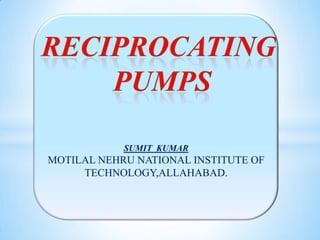
Reciprocating pumps
- 1. * SUMIT KUMAR MOTILAL NEHRU NATIONAL INSTITUTE OF TECHNOLOGY,ALLAHABAD.
- 2. Positive Displacement Pump Linear Type Reciprocating Type Rotary Type Piston Pump Diaphragm Pump then forcing (displacing) that trapped volume into the discharge pipe. * Causes a fluid to move by trapping a fixed amount of it and Also known as “Constant Flow Machines”
- 3. Pushing of liquid by a piston that executes a reciprocating motion in a closed fitting cylinder. Crankshaft-connecting rod mechanism. * Conversion of rotary to reciprocating motion. Entry and exit of fluid.
- 4. Cylinder. Suction Pipe. Delivery Pipe. * Suction valve. Delivery Valve.
- 5. Triplex No generation of head. Because of the conversion of rotation to Crank-shaft Rotation linear motion, flow varies within each pump revolution. * Flow variation for the triplex Quintuplex reciprocating is 23%. Flow variation for the quintuplex pump is 7.1%. Crank-shaft Rotation
- 6. Reciprocating Pump Pressure Provides a nearly constant flow rate Centrifugal over a wider range of pressure. Pump Fluid viscosity has little effect on the flow rate as the pressure increases. * Flow Rate
- 7. They are reciprocating pumps that use a plunger or piston to move media through a cylindrical chamber. It is actuated by a steam powered, pneumatic, hydraulic, or electric drive. Other names are well service pumps, high pressure pumps, or high viscosity pumps. Cylindrical mechanism to create a reciprocating motion along an axis, which then * builds pressure in a cylinder or working barrel to force gas or fluid through the pump. The pressure in the chamber actuates the valves at both the suction and discharge points. The volume of the fluid discharged is equal to the area of the plunger or piston, multiplied by its stroke length.
- 8. A diaphragm pump is a pump that uses a combination of the reciprocating action of a rubber, thermoplastic or teflon diaphragm and suitable non-return check valves to pump a fluid. Has been developed for handling corrosive liquids and those containing suspensions of abrasive solids. In one section a piston or plunger operates in a cylinder in which a non-corrosive fluid is * displaced.. The movement of the fluid is transmitted by means of flexible diaphragm to the liquid to be pumped. The only moving parts of the pump that are in contact with the liquid are the valves, and these can be specially designed to handle the material. In some cases the movement of the diaphragm is produced by direct mechanical action, or the diaphragm may be air actuated.
- 9. * Suitable for discharge pressure up to 1,200 bar have . Good dry running characteristics. Are low-shear pumps. Can be used to make artificial hearts. Are used to make air pumps for the filters on small fish tanks. Can be up to 97% efficient. Can handle highly viscous liquids. Are available for industrial, chemical and hygienic applications.
- 10. A vacuum is created inside the pump casing each time the diaphragm is raised. This opens the inlet valve and seals the discharge valve allowing water and air to enter the pump. When the diaphragm is lowered the * resulting pressure seals the inlet and opens the outlet valve purging the pump housing of water and air. Unlike centrifugal designs the water inside the casing is positively displaced and no recirculation occurs.
- 11. Power=(Δp*Q)/ ΔP: Change in total pressure between the inlet and outlet. Q: Discharge of the pump. : Efficiency. V2 Q=(ALN)/60. Q: – Discharge of the pump, m3/sec. * A: – Cross-section of piston or cylinder, m2. Δz L: – length of stroke in meter, m. L N: – speed of crank, r.p.m. V1
- 12. The ratio of the power imparted on the fluid by the pump in relation to the power supplied 60% 50% to drive the pump. Ratio, r 90% Volumetric efficiency : (Discharge volume / Suction volume)-slip C S Discharge Pressure r = (VC+VS)/VS =1+(VC/VS) Mechanical efficiency : loss occurs while % of full speed 44 50 * 73 100 overcoming mechanical friction in bearing M.E, % 93.3 92.5 92.5 92.5 and speed reduction. % of full-load Speed of piston= (stroke)*(rpm)/(30000). developed pressure 20 40 60 80 100 (mm) M.E,% 82 88 90 92 92
- 13. Agriculture. Chemical. Desalination. Horizontal Drilling. General Industries. Mining. * Oil and Gas. Pulp and Paper. Sewer Cleaning. Steel.
- 14. Loses flow as the viscosity Increases flow due to thickening of goes up. the flow. μ Changes in pressure has a Changes in pressure has little effect dramatic effect on efficiency. on efficiency. Very inefficient at even modest P * Very efficient with high viscosity. viscosity. μ
Editor's Notes
- Power imparted into a fluid. increase the energy of fluid.The total pressure may have gravitational, static pressure and kinetic energy components; i.e. energy isdistributed between change in the fluid's gravitational potential energy (going up or down hill), change in velocity, orchange in static pressure.
- Slip (S) is the loss of capacity due to internal and external pump leakage.These include the plungers and packing, the crossheads, the rod seals,and the bearings. The efficiency of a single acting pump often exceeds 90%, while a doubleactingpiston pump will be 88% due to the additional piston and rod seals. If the pump isequipped with internal gearing, an additional 2% loss is common.
- facilitate the removal of cuttings, stabilize the bore hole, cool the cutting head, and lubricate the passage of the product pipeMarkets.Pumps have two main purposes:Transfer of liquid from one place to another place (e.g. water from an underground aquifer into a water storage tank)Circulate liquid around a system (e.g. cooling water or lubricants through machines and equipment)Reciprocating pumps are used only for pumping viscous liquids and oil wells.
- higher viscosity liquids fill the clearances of the pump causing a higher volumetric efficiency.Because the centrifugal pump operates at motor speed, efficiency goes down as viscosity increases due to increased frictional losses within the pump.